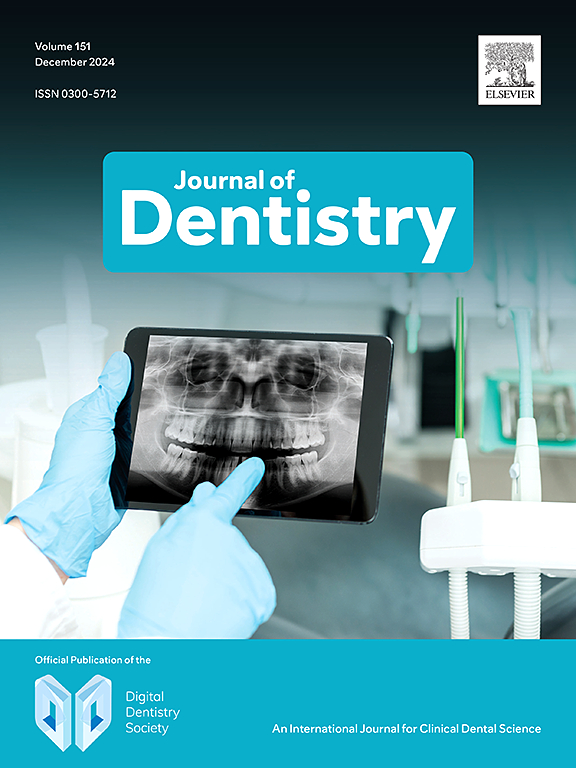非可燃尼古丁产品对口腔健康的影响:随机对照试验的系统综述和网络meta分析
IF 5.5
2区 医学
Q1 DENTISTRY, ORAL SURGERY & MEDICINE
引用次数: 0
摘要
目的:通过系统综述和网络荟萃分析,评价非可燃尼古丁产品(NCNPs)与相互对照、安慰剂、标准治疗、不治疗和可燃香烟的口服不良反应。数据来源和研究选择:纳入了涉及成年吸烟者并报告口腔不良事件(如口腔刺激、口干、口腔溃疡)的随机对照试验。PubMed、Scopus和Cochrane CENTRAL的检索截止到2024年8月。使用RoB 2评估偏倚风险,使用CINeMA评估证据确定性。结果:纳入36项试验,其中21项用于网络荟萃分析。大多数与安慰剂的比较显示在四个主要结果上没有显著差异。与标准护理组相比,尼古丁替代疗法(NRT)牙龈组发生阿弗特溃疡的几率明显更高(OR = 2.36;95% ci: 1.05-5.30)。电子烟引起口腔刺激的几率也更高(OR = 4.06;95% CI: 1.67-9.85), NRT口腔喷雾剂(OR = 4.36;95% CI: 1.14-16.63), NRT口香糖(OR = 4.25;95% CI: 1.51-11.94)和鼻烟(OR = 13.56;95% CI: 1.07-171.52)。敏感性分析证实了主要发现。次要结果显示孤立的关联,但基于有限的数据。证据确定性低至非常低,主要是由于不精确和偏倚风险。结论:NCNPs的耐受性良好。大多数安慰剂比较显示没有增加风险,尽管与标准护理相比,一些产品显示出更高的阿弗顿溃疡和口腔刺激的几率。需要更好地报告随机对照试验中的口服不良事件。临床意义:鉴于目前证据基础的局限性,牙科专业人员应通过监测NCNP使用期间的口腔健康状况,并根据安全性、耐受性和患者个体需求支持产品选择,在减少烟草危害战略中发挥积极作用。本文章由计算机程序翻译,如有差异,请以英文原文为准。
Oral health effects of non‑combustible nicotine products: a systematic review and network meta‑analysis of randomized controlled trials
Objectives
To evaluate the oral adverse effects of non-combustible nicotine products (NCNPs) compared with each other, placebo, standard of care, no treatment and combustible cigarettes through a systematic review and network meta-analysis.
Data sources and study selection
Randomized controlled trials involving adult smokers and reporting oral adverse events (e.g., mouth irritation, dry mouth, aphthous ulcers) were included. PubMed, Scopus, and Cochrane CENTRAL were searched up to August 2024. Risk of bias was assessed using RoB 2, and evidence certainty with CINeMA.
Results
Thirty-six trials were included, with 21 contributing to the network meta-analysis. Most comparisons with placebo showed no significant differences across four primary outcomes. The odds of developing aphthous ulcers were significantly higher in the nicotine replacement therapy (NRT) gum group compared with standard of care (OR = 2.36; 95 % CI: 1.05–5.30). Higher odds of mouth irritation were also observed for e-cig (OR = 4.06; 95 % CI: 1.67–9.85), NRT mouth spray (OR = 4.36; 95 % CI: 1.14–16.63), NRT gum (OR = 4.25; 95 % CI: 1.51–11.94) and snus (OR = 13.56; 95 % CI: 1.07–171.52) when compared with standard of care. Sensitivity analyses confirmed the main findings. Secondary outcomes revealed isolated associations but were based on limited data. Evidence certainty was low to very low due mainly to imprecision and risk of bias.
Conclusions
NCNPs appear to be generally well tolerated. Most placebo comparisons showed no increased risk, although some products exhibited higher odds of aphthous ulcers and mouth irritation compared with standard of care. Better reporting of oral adverse events in RCTs is needed.
Clinical significance
Given the current limitations of the evidence base, dental professionals should play an active role in tobacco harm reduction strategies by monitoring oral health during NCNP use and supporting product choice based on safety, tolerability, and individual patient needs.
求助全文
通过发布文献求助,成功后即可免费获取论文全文。
去求助
来源期刊

Journal of dentistry
医学-牙科与口腔外科
CiteScore
7.30
自引率
11.40%
发文量
349
审稿时长
35 days
期刊介绍:
The Journal of Dentistry has an open access mirror journal The Journal of Dentistry: X, sharing the same aims and scope, editorial team, submission system and rigorous peer review.
The Journal of Dentistry is the leading international dental journal within the field of Restorative Dentistry. Placing an emphasis on publishing novel and high-quality research papers, the Journal aims to influence the practice of dentistry at clinician, research, industry and policy-maker level on an international basis.
Topics covered include the management of dental disease, periodontology, endodontology, operative dentistry, fixed and removable prosthodontics, dental biomaterials science, long-term clinical trials including epidemiology and oral health, technology transfer of new scientific instrumentation or procedures, as well as clinically relevant oral biology and translational research.
The Journal of Dentistry will publish original scientific research papers including short communications. It is also interested in publishing review articles and leaders in themed areas which will be linked to new scientific research. Conference proceedings are also welcome and expressions of interest should be communicated to the Editor.
 求助内容:
求助内容: 应助结果提醒方式:
应助结果提醒方式:


